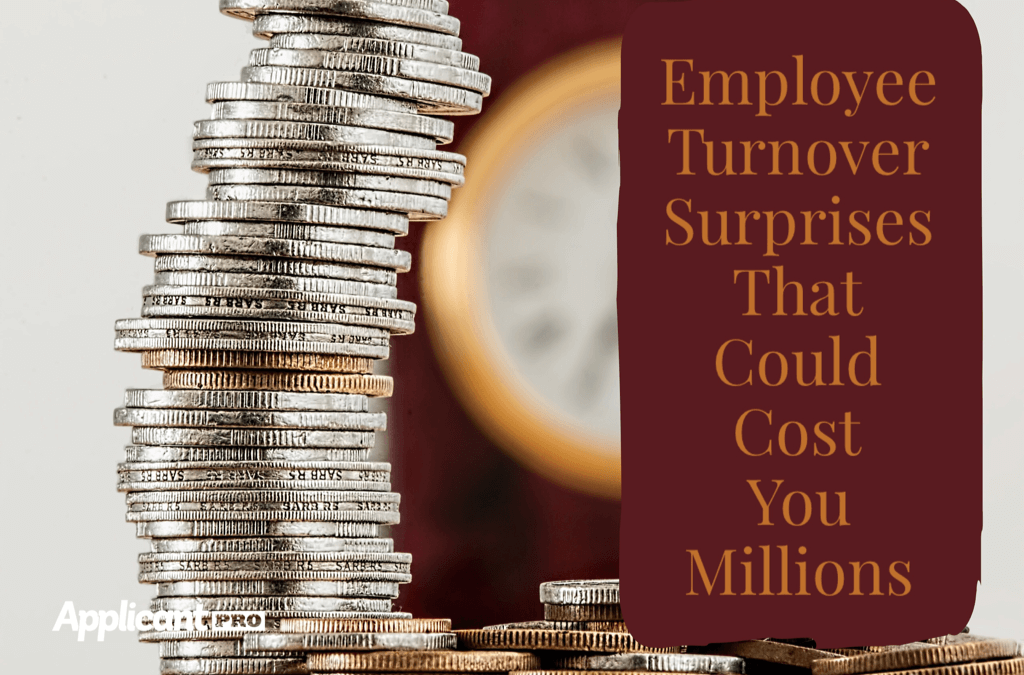
Employee Turnover Surprises that Could Cost You Millions
Employee turnover is a phrase you hear a lot about as an HR professional. In fact, you may be so well acquainted with it that you can easily spout off employee turnover percentages to almost every person at your company. But what if I told that everything you thought you know about employee turnover rates is probably wrong? So wrong that you could actually be costing your company millions of dollars without even realizing it.
The idea is a scary one, but it's not as unreasonable and unrealistic as you might think.
The idea is a scary one, but it's not as unreasonable and unrealistic as you might think. Dr. John Sullivan published an article on ERE recently sharing the dangers of HR professionals miscalculating or rather misrepresenting employee turnover numbers. His insights are eye-opening. It's not that HR purposely fabricates these numbers, but rather if the business impact isn't factored into your employee turnover, then your actual rates and employee turnover costs could be much more than what you had originally calculated. Just look at this article from eremedia.com. Here are some of the key questions to ask yourself when calculating actual employer turnover impact:
Did the employee turnover occur in a high impact position?
It's easy for HR to get caught up in the "everyone's worth the same" mentality because from a generalized people perspective, that's true. One person doesn't hold greater value than another, but that's not really the case for business because certain positions have a higher impact than others. For example, if you lose someone in a high revenue generating position like Sales, the financial loss you suffer will likely be greater than if you're replacing someone in an Admin position. Another high impact loss from the perspective of employee turnover is losing a member of your C-suite because their sphere of influence is far-reaching. They also have a lot of responsibilities that involve business decisions which could affect your business's bottom line.
Was the employee turnover associated with a high impact individual?
It's not uncommon to suffer an employee turnover loss that has a surprisingly large impact because the individual is a key player at the company regardless of his/her position. For instance, the employee could have been an innovator or extremely reliable during a time when your staff is more unpredictable. He/she could also have been an influencer. Someone that many of your employees relied upon for inspiration. Their departure could also signal to other employees that there's turbulence at the company and cause an employee turnover chain reaction.
Did your company lose money after you found a replacement for the former employee?
This point is a little more obvious to calculate because it's fairly easy to measure how much revenue was produced before the employee turnover occurs versus afterward. Obviously, you have to take into consideration how long it takes the employee to become comfortable in his/her position after learning the ropes, but if you replace a former employee with someone that under performs, that cost should also be factored into your employee turnover costs.
Conclusion
It's vital that you view the situation from a strategic perspective.
When it comes to accurately pinpointing employee turnover rates, it's vital that you view the situation from a strategic perspective. Assess your employee turnover figures from the lens of business because lumping all of your new hire employee turnover into one unweighted category and then sharing this figure with your executive team is severely misleading. So misleading in fact that it could be costing your organization hundreds of thousands or even millions of dollars.
Even though the financial strain isn't immediately obvious, it plays a big role in calculating the actual costs associated with your employee turnover versus the perceived costs. Building an employee turnover framework that factors in all of these variables not only increases your strategic credibility, but it could also help you build a case for upping your recruiting budget. Check out our article on explaining time to fill to your executive team for even more info on saving revenue when you've lost an employee.
Feeling like calculating realistic employee turnover costs is out of your reach because the numbers overwhelm you? Let our hiring experts help! Call us today for a free consultation.

Sick of getting ghosted by applicants?
Mitigate ghosting with these few tips
Talent Acquisition Technology 2025: Your Essential Market Guide
Unlock key insights on hiring tech trends.
Curious what isolved Talent Acquisition is all about?
Find out how we can help you streamline and optimize your hiring process!
Related Articles

How to Create a Stellar Candidate Experience
Create a standout hiring experience that attracts top talent with these essential tips. Learn how to improve communication, streamline interviews, and enhance onboarding to make every candidate feel valued.

Is AI Making Hiring Impossible?
Have you noticed the growing trend of job seekers using AI to create resumes, cover letters, and complete assessments? Learn strategies for spotting AI-generated applications, and how employers can adapt their recruitment processes to ensure they hire qualified candidates.

How Western States Lodging and Management Optimized Applicant Outsourcing
See how Western States Lodging and Management achieved an 800% increase in qualified applicants for assisted living roles. Learn how they optimized applicant outsourcing with data-driven strategies.